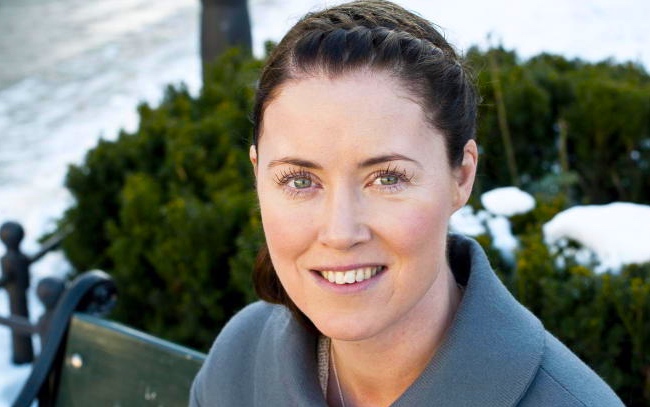“Did I want to live? my mum asked me when the cake was eaten. Did I? Her eyes bored into mine. I’m falling away, were the words that came to me. Words spoken only as thoughts. Repeated over and over again. I’m falling away, I’m falling away from all that is living. And my sleep at nights. As if I were crossing the sea on stilts. Striding high above the waters, the curve of the earth in front of my eyes.”
 In the most fervently psychological novel I have read in many years, Swedish author Linda Bostrom Knausgard tells the inner stories of an almost totally dysfunctional family in Stockholm. An eleven-year-old girl who has stopped talking “a long time ago,” reveals that her mother and brother are now accustomed to her silence and that her father is dead. School for this silent child is the equivalent of “walking into pitch darkness every day – [like] having to hold on to a handrail until it was time to go home.” When she arrives at home, she finds her older brother inside his room with the door nailed shut. Her actress mother has given her a notebook in which she can write if she wants to communicate something with her mother, but she has not used it. “The notebook was a kind of consent. She was accepting my silence…leaving me alone.” The child admits that she stopped talking when growing began to “take up too much space inside me….Wish something of me, I could say. But I could never make any wish come true. Not really.”
In the most fervently psychological novel I have read in many years, Swedish author Linda Bostrom Knausgard tells the inner stories of an almost totally dysfunctional family in Stockholm. An eleven-year-old girl who has stopped talking “a long time ago,” reveals that her mother and brother are now accustomed to her silence and that her father is dead. School for this silent child is the equivalent of “walking into pitch darkness every day – [like] having to hold on to a handrail until it was time to go home.” When she arrives at home, she finds her older brother inside his room with the door nailed shut. Her actress mother has given her a notebook in which she can write if she wants to communicate something with her mother, but she has not used it. “The notebook was a kind of consent. She was accepting my silence…leaving me alone.” The child admits that she stopped talking when growing began to “take up too much space inside me….Wish something of me, I could say. But I could never make any wish come true. Not really.”
The child, who does not even share her name – Ellen – till well into the book, blames herself for her father’s death because she had “prayed out loud to God for him to die and he did,” concluding that “you should never ask for what you want. It disturbs the order of things.” For her, “The days and nights are the same. The silence softens the edges so everything is like a kind of mist.” Once she had friends, but no longer, and though she used to sing in the school choir, she now lives in silence. She sits alone at lunch at school and no one speaks to her. Her teacher was reduced to tears after Ellen’s silence lasted a week, but her mother insists to the teacher that “it” is something Ellen will outgrow and to let her be. In the meantime, Ellen is visited by the ghost of her father at night and is afraid of her brother, who keeps her imprisoned in the bathroom when he is bored with her, and makes her his slave when her mother is working.
All these confessions occur in the first twenty or so pages of the book, at which point Ellen begins to broaden her background for the reader by recreating events from the past in the random order of her memories – the death of her father, her mother’s belated discovery that she herself has acting talent, her mother’s eventual schooling at the Royal Dramatic Theatre, her estranged father’s traumatic visits to their house and his death wishes, her brother’s girlfriend and the turmoil she creates, her parents’ divorce, her father’s decision to raise trotter horses on a remote farm which he cannot afford, the relief the whole family feels with her father’s death, but also her memories of visiting Grona Lund, an amusement park with her father sometime in the past. Scenes swirl through past and present as the child recollects events and dreams and admits in several places that she no longer feels safe. At no point does she get the help she so obviously needs from people qualified to offer it, and the whole family seems content to believe that things will improve on their own for Ellen as she grows up, always believing that they are “a family of light.”
For those who love psychological novels, this novel offers many challenges and rewards, but others may become impatient at the fact that no one who could offer real help – her parents, her teachers, and acquaintances – seems to recognize the obvious need of some kind of professional intervention with this eleven-year-old child who is at the mercy of her memories and her fears. Becoming mute for weeks or months is more than just a passing phase, and I became frustrated that no action was being taken by her mother or teachers.
In trying to figure out why the author chose to depict issues in this way, I did some research and learned that the author herself suffers from bipolar disorder, which was the subject of a radio documentary in Sweden which she herself produced in 2005, so she has a long history of self-analysis. A poet, short story writer, and author of a previous novel, The Helios Disaster, before she wrote this book, she is the daughter of an actress, Ingrid Bostrom, and was married from 2007 – 2016 to famed author Karl Ove Knausgard with whom she has four children. Her former husband’s six-volume autobiography, written during their marriage, has been hugely successful throughout the world, but it has also been controversial for its full disclosure of relationships with real people and what some consider an invasion of privacy.
Of this book, Linda Bostrom Knausgard herself says on the book jacket, “Silence, or not speaking, is a theme I recognize from my own childhood. To speak and then suddenly not speak – I’ve experienced that. As a child I fantasized about not speaking when I was angry at my mother: ‘I won’t say a word, not a word!’ But I didn’t have the strength that Ellen in the book has. I held out two or three days at most, and it felt good. But then life carried on. After I coined the phrase ‘It’s a long time already since I stopped talking,’ the story just fell into place.”
Intense and revelatory of the many fears and nightmares which can hide behind the silence – real or symbolic – in the mind of a pre-teen, Knausgard reminds readers that silence does not mean acceptance or passivity, that real drama may be unfolding behind the mask that hides the pain. While outside specialists and teachers had little or no chance to meet Ellen’s emotional needs, the author seems to offer some encouragement that families who care about each other do have the ability to see beyond immediate issues and eventually to deal with their problems on the family level. Whether or not they can heal themselves, long-term, without help, is not answered here, and “Welcome to America,” shouted by Ellen’s psychotic father late in life as he confronts roaring traffic, remains meaningless.
Photos. The author’s photo appears on http://www.lzypnh.co/
The Royal Dramatic Theatre, where Ellen’s mother attended classes, is from https://www.123rf.com
Ellen’s father took her to Grona Lund amusement park, on one occasion, an experience she did not enjoy. https://www.tripadvisor.es
The ferry from Grona Lund back to the center of the city is shown on http://tiowoo.trusbu.se/




